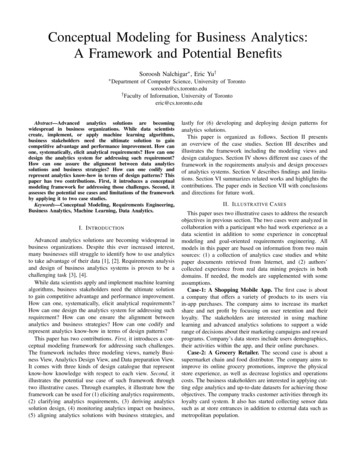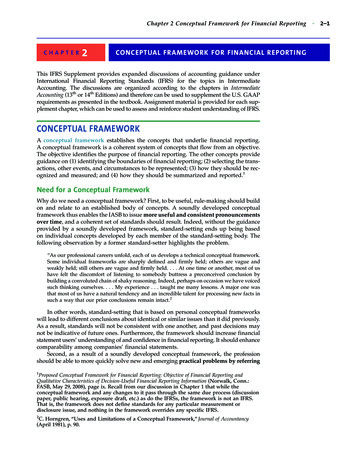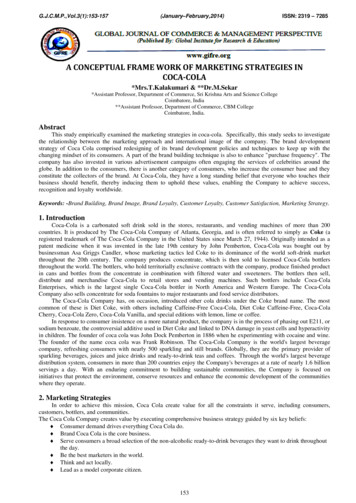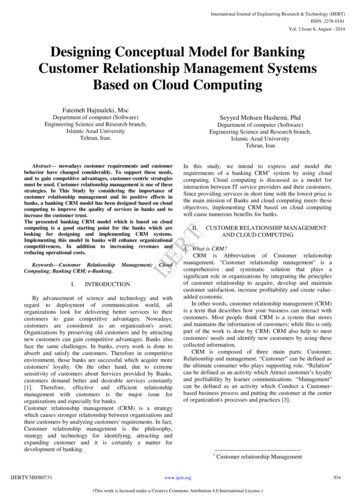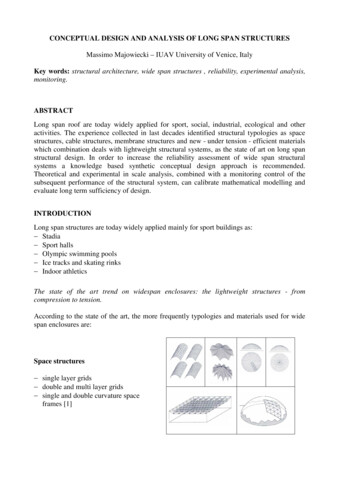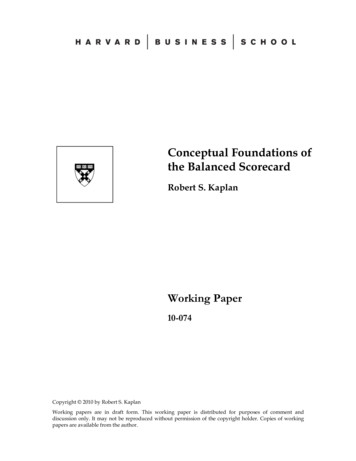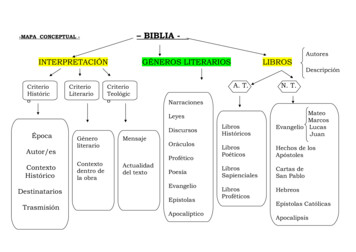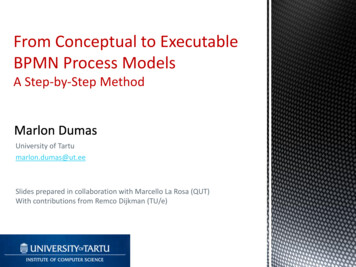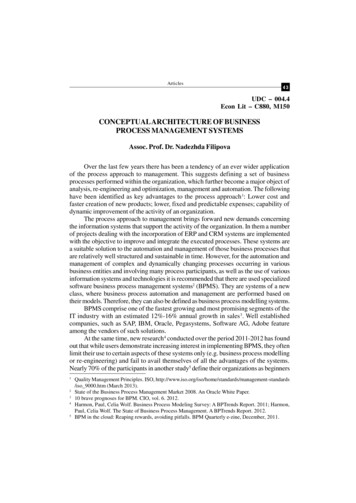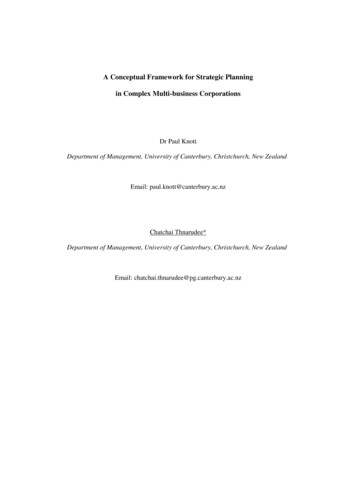
Transcription
A Conceptual Framework for Strategic Planningin Complex Multi-business CorporationsDr Paul KnottDepartment of Management, University of Canterbury, Christchurch, New ZealandEmail: paul.knott@canterbury.ac.nzChatchai Thnarudee*Department of Management, University of Canterbury, Christchurch, New ZealandEmail: chatchai.thnarudee@pg.canterbury.ac.nz
A Conceptual Framework for Strategic Planningin Complex Multi-business CorporationsABSTRACTIn response to dynamic market demands and hypercompetition, multi-business corporations havetypically adopted a complex multidivisional structure or M-form. At the same time, they continue touse strategic planning as a key mechanism for coordinating strategy formulation across the complexM-form. Consequently, in these corporations strategic planning can no longer be regarded as a singlecorporate process. Instead, it has evolved into a network of multi-level and multi-unit strategicplanning processes. Multi-business corporations must synthesise, align and synergise this network ofplanning processes at the corporate centre to form integrated processes and practices. In this paper,we addresses this challenge by providing a conceptual framework for examining multi-level andmulti-unit strategic planning processes in complex multi-business corporations.Keywords: Strategic Planning, Multi-unit, Multi-level, Multi-business, Hierarchy.
INTRODUCTIONStrategic planning has been a central topic in strategy research for many years. Strategic planningresearch continues to debate the relationship between strategic planning and firm performance, and toinvestigate the nature of strategic planning process. Recently, research on strategic planning has beenenriched by the lens of micro-strategy and strategising perspective (Johnson, Langley, Melin, &Whittington, 2007). This probes the activities inside a strategic planning process in order to improveour understanding of how firms carry out strategic planning activities in practice. An importantlimitation of strategic planning research to date is that it has always viewed strategic planning as asingle process in a corporation. This, we argue, is insufficient given the evolution of the complexmultidivisional organisation structure or the M-form (Chandler, 1982) that many multi-businesscorporations currently adopt.When corporations adopt a complex M-form, their strategic planning needs become morehierarchically complex since they expand into and across different organisational levels and units.Consequently, multi-level and multi-unit strategic planning processes have evolved within multibusiness corporations in order to bridge these multiple levels of decision-making and multipledimensions of organisational structure. However, it is extremely difficult for multi-businesscorporations to manage this complex hierarchy of strategic planning processes effectively, flexibly andintegratively. It is a significant challenge for them to synthesise and align their multi-level and multiunit strategic planning activities into an integrated set of processes and practices. This paper aims toshed light on this challenge by proposing a conceptual framework for examining strategic planningprocesses that are complex and hierarchically structured. We first review the relevant literature beforederiving the conceptual framework.2
RESEARCH ON STRATEGIC PLANNINGStrategic planning has been researched for many decades, and continues to be a central topic instrategy research (Grant, 2003). Empirical research on strategic planning has focused on three mainareas: (1) the effect of strategic planning on firm performance, (2) the process of strategic planning instrategic decision making, and (3) the activities of strategy practitioners in strategic planning practice.We review each of these areas as they apply to multi-level strategic planning processes in multibusiness corporations.Strategic planning and performanceThe question of how strategic planning contributes to performance has spawned many studies but novigorous and consistent findings. Evidence regarding the relationship between strategic planning andperformance has been criticised as equivocal (Rudd, Greenley, Beatson, & Lings, 2008). While thereis empirical support for a positive association between strategic planning and performance (Brews &Purohit, 2007; Ebben & Johnson, 2005), there is, on the other hand, evidence suggesting that no suchrelationship exists (Boyd & Reuning-Elliott, 1998; Greenley, 1986). The contribution of this area ofresearch has been limited by the inconsistency of its measurement schemes, and a priori assumptionsof strategic planning dimensions and factors. Arguably, by viewing strategic planning as a singleprocess in a corporation, this research has limited its ability to establish clear correlations betweenplanning and performance in multi-business corporations. One possible development from theconceptual framework we propose in this paper would be to study the planning-performancerelationship based on a fuller representation of complex multi-level and multi-unit strategic planningprocesses.The process of strategic planning in strategic decision makingA recent survey on strategic planning conducted by The McKinsey Quarterly in 2006 (Dye & Sibony,2007) found an enormous amount of dissatisfaction among executives. Many of them felt that theirstrategic planning needed to be improved. They raised significant concerns about the way their3
company executed the strategy, communicated it, aligned the organisation with it, and measuredperformance against it. The survey revealed the following key suggestions for improving theirstrategic planning: (1) improving their company’s alignment with the strategic plan, (2) developing amethod to monitor progress against the plan, (3) increasing involvement from all levels of company,and (4) improving efficiency of planning process.The literature we review below has attempted to address this dissatisfaction by establishing effectiveand adaptive strategic planning systems for entire corporations that synthesise deliberate and emergentperspectives. However, we argue that this synthesis becomes much more difficult if multi-level andmulti-unit strategic planning processes are taken into account. This is because of the high level ofcoordination that is required to ensure strategy formation is effectively aligned between each level andunit.Within the literature on the strategy process perspective, the efficacy of deliberate strategic planningversus emergent strategic planning is an ongoing debate (Rudd et al., 2008; Wit & Meyer, 2005).Brews and Hunt (1999) suggest that lessons from both design and learning schools are needed forsuccessful strategic planning. By combining the deliberate, rational and linear process of the designschool and the adaptive, incremental and complex learning process of the learning school, a moreproductive result can be achieved. Moreover, Grant (2003) refers to the long debates between thestrategy-as-rational-design and strategy-as-emergent-process schools, and points to a process of‘planned emergence’ in which strategic planning system provides a mechanism for coordinatingdecentralised strategy formulation within a structure of demanding performance targets and clearcorporate guidelines.Similarly, a practical study carried out by Marakon Associates, published by the Harvard BusinessReview in January 2006 (Mankins & Steele, 2006), argues that a number of companies have improvedtheir strategic planning by replacing their calendar-driven and business unit-focused planningprocesses with continuous and issues-focused decision making. By changing the timing and focus of4
strategic planning, these companies have also changed the nature of top management’s discussionsabout strategy, from ‘review and approve’ to ‘debate and decide’. This means that senior executivesseriously think through every major decision and its implications for the company’s performance andvalue. Indeed, these companies use this new way of thinking for strategic planning process to drivefaster decision making. This study also showed that these companies make more than twice as manyimportant strategic decisions each year as companies that still follow the traditional strategic planningmodel.Further, in strategy literature concerned with corporate strategic planning systems in multi-nationalcompanies, Grant (2003) conducted comparative case studies of the strategic planning systems of eightoil companies to explore the changing characteristics of their strategic planning processes. He foundthat multinational companies continue to have formal strategic planning process, but with a shift in thenature of strategy work away from analysis and forecasting, and more towards communication,coordination and control. He suggested that strategic planning is now more about coordinatingstrategies as they develop from within the business, communicating adopted strategies, and monitoringand controlling their implementation. According to this research, the strategic planning process acts asa context for strategic decision making as well as for coordination of its decentralisation, and providesa mechanism for control (Grant, 2003). Arguably, however, these findings were not able to bedeveloped to their full potential due to the focus of this research on studying the strategic planningsystem as a single process in a corporation.In summary, strategy process research on strategic planning has not so far explicitly taken into accountthe perspective that strategic planning is a complex multi-level and multi-unit process.5
The activities of strategy practitioners in strategic planning practiceThe last area of research on strategic planning is relatively new and considered as an emergingresearch domain on strategic planning. This emerging domain, through the lens of a strategy-aspractice perspective, has explored and probed into what is going on inside strategic planning episodes(Hodgkinson, Whittington, Johnson, & Schwarz, 2006; Jarzabkowski, 2003; Paroutis & Pettigrew,2007; Whittington, 2006; Whittington, Molloy, Mayer, & Smith, 2006). It has been particularlyinterested in the practical activities and tools necessary to make strategic planning happen. Thisperspective has evolved in response to the limitations of process and performance studies, which donot investigate how managers and strategists undertake the activities needed to run their strategicplanning system effectively.Hodgkinson, Whittington, Johnson, and Schwarz (2006) studied the role of strategy workshops instrategy development processes. They found that strategy workshops are a common practice incontemporary organisations and that they are part of regular formal strategy development processes.According to their findings, strategy workshops seem to play an important role in introducing a degreeof emergence within a wider formal strategic planning framework. They are the forums in which suchemergent strategy is thought through, translating, legitimising and formalising strategy that originateslower down the organisation. In sum, these researchers found that strategy workshops and strategyaway-days, as the popular tools for driving corporate strategic planning, play a significant role inintroducing a degree of emergence within a wider formal strategic planning framework.Jarzabkowski (2003) presented an empirical investigation of the micro practices of strategy in threeUK universities during strategy processes, including strategic planning. Empirically, the findings fromthis study revealed that the universities instigated the strategic planning cycle to provide an integrativeframework of direction setting, resource allocation and monitoring and control. The strategic planningrapidly engaged with contradictions by enabling constituents to synthesise interpretations and developmore unitary frameworks of activity. Furthermore, this researcher suggested that the strategic planning6
cycle is a powerful practice for distributing an increasingly consistent interpretation of desirablestrategic activity based upon accountability and financial viability (Jarzabkowski, 2003).Paroutis and Pettigrew (2007) examined how central and peripheral teams of strategists in the multibusiness firm, through their daily practice, adopt recursive and adaptive behaviours during the strategyprocess. Accordingly, these researchers focused on the actions and the interactions of strategy teamsbetween the corporate centre and the business unit levels within the multi-business firm. From theirfindings, the activities of strategy teams evolved alongside the strategy process. The adoption ofrecursive and adaptive activities by strategy teams was closely linked with the strategy process. Inaddition, these researchers suggest that the notions of strategy process and practice were interrelatedwhen examining how strategy teams strategise both at the corporate centre and at business unit level(Paroutis & Pettigrew, 2007).These practice-based studies have shed light on the practical activities of strategy practitioners withinstrategic planning. However, like the process-based studies, they have studied strategic planning as asingle strategic planning process for whole corporations. They have focused only on the activitiestaking place at the corporate level and the periphery. The broader analysis of planning activities withincomplex multi-level and multi-unit strategic planning processes has yet to be explored. The followingsection derives a conceptual framework designed to facilitate this multi-level, multi-unit research.7
A CONCEPTUAL FRAMEWORK FOR MULTI-LEVEL, MULTI-UNIT PLANNINGOur literature review shows that existing strategy research on strategic planning assumes a singlecorporate strategic planning process for an entire corporation. In this section, we show why this isinsufficient for studying strategic planning across complex corporate structures, and hence devise
use strategic planning as a key mechanism for coordinating strategy formulation across the complex M-form. Consequently, in these corporations strategic planning can no longer be regarded as a single corporate process. Instead, it has evolved into a network of multi-level and multi-unit strategic planning processes. Multi-business corporations must synthesise, align and synergise this network of
